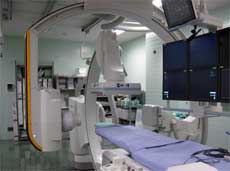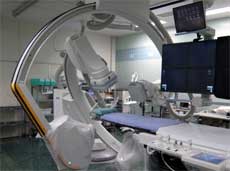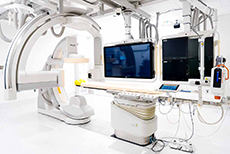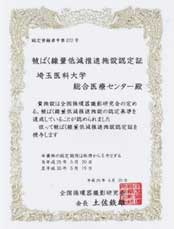![]()
Vascular Imaging
September 2,2019 Update
Introduction to the examination room
Vascular imaging is performed by inserting a thin tube (catheter) through an artery such as at the base of the leg (the femoral artery), the elbow (brachial artery), or the wrist (radial artery). A catheter is advanced to the desired blood vessel by viewing a fluoroscopic image (X-ray), and a contrast agent is injected in order to examine to see the movement and condition of the blood vessels and to dye tumors. This is sometimes shortened and called Angio.
In recent years, we have been performing more endovascular treatments (Interventional Radiology: IVR) to inject anti-cancer drugs to treat cancer, expand the narrowed parts of blood vessels, inserting an embolic substance to block blood flow at a bleeding site, cancer or aneurysm, instead of performing surgical operations.
There are three vascular imaging devices operating in the vascular imaging room of the Department of Radiology; a vascular imaging device with a focus on the head and neck area (PHILIPS Allura Clarity FD20/15), a vascular imaging device with a focus on the cardiac area (SIEMENS: AXIOM Artis dBC), and a vascular imaging device (SIEMENS: AXIOM Artis dBA) that covers the entire body area.
The Vascular Imaging Division is engaged in the examination and treatment by physicians, nurses, medical radiologists, and clinical engineering engineers (when cardiac area), and they are working together as staff.

AXIOM Artis dBA

AXIOM Artis dBC

Allura Clarity FD20/15
Radiation dose reduction promotion facility accreditation

We are working with medical radiologists in cooperation with doctors to be able to perform examinations and treatment with minimal exposure.
In May 2013, we acquired the certification as a Radiation dose reduction promotion facility as designated by the National Cardiovascular Imaging Research Group, which makes us the fourth facility in the prefecture to do so.
Time for examination/Important points
Most of the tests and treatments are carried out inpatient. The details will be explained by the attending doctor or the nurse. Please contact us if you have any questions.
Before the Examination
- Do not eat any meals prior to the examination (about 4 hours) on that day.
- Please drink water and tea as usual so that you do not get thirsty.
- You may not be able to have an examination with the contrast agent depending on the content of the disease that is currently or was previously being treated, so please consult with your doctor. (Asthma, hyperthyroidism, multiple myeloma, primary macroglobulin, pheochromocytoma, renal dysfunction, etc.)
- Please be sure to talk to your doctor if you have had any side effects before when using a contrast agent.
- Please continue to take the medicines you are taking as usual unless otherwise instructed. You may be asked to refrain from taking some medications for diabetes.
During the Examination
- The patient's condition will be checked by using an electrocardiogram, and a blood pressure monitor, etc., so that examination can be performed safely.
- An intravenous drip may be performed depending on the contents of the examination.
- We will inject an anesthetic in the location beforehand in order to insert the catheter. Because this is a local anesthesia, you will remain conscious.
- When the contrast agent is injected, your body may feel hot, but do not worry because this will disappear when the injection ends. There is a rare possibility that side effects may occur, so please do not hesitate to let us know if you feel sick.
- We may ask for your cooperation such as having you hold your breath or not move your body during the examination.
- Angiography takes around one hour, and endovascular treatment takes around two hours. It may take more time than that depending on the contents of the examination and the treatment, but because it punctures the artery, you should not move during the examination. If anything occurs, please feel free to let us know and we will respond immediately.
After the Examination
- There will be strong pressure applied at the puncture site to prevent bleeding. The time for this varies depending on the puncture site, but the pressure will be applied for 3-5 hours.
- The contrast agent is excreted from the body in the urine. In order to encourage the excretion of the contrast agent, patients who do not have limits on fluid intake should please drink a little more water and tea than usual.
- In rare cases, symptoms such as headaches, itching, nausea, eczema, dizziness, etc. may appear a few hours or a few days after the use of a contrast agent. Any persons who see any of these symptoms should consult with the doctor or the nurse.
Contact information
049‐228‐3519 [Department of Radiology, Vascular Imaging Room Direct]




